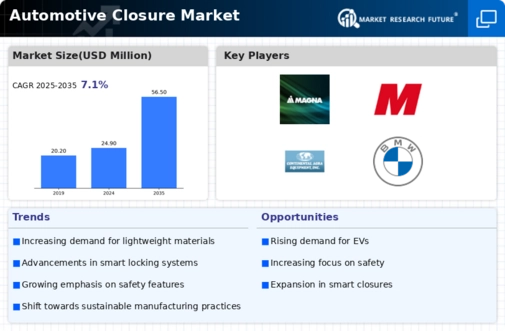Automotive Closure Size
Automotive Closure Market Growth Projections and Opportunities
The automotive closure market, encompassing components like doors, hoods, and trunks, operates within a dynamic landscape shaped by various factors. Primarily, consumer demand and technological advancements drive this market's dynamics. Consumer preferences for safety, convenience, and aesthetics significantly influence the design and features of automotive closures. Safety concerns prompt the integration of advanced locking systems and impact-resistant materials, while convenience leads to the development of power-operated closures and hands-free functionalities, catering to modern lifestyles.
Additionally, regulatory standards and environmental consciousness play pivotal roles in shaping market dynamics. Stricter regulations on emissions and vehicle safety standards necessitate continuous innovation and adaptation within the automotive closure sector. Manufacturers constantly strive to balance compliance with evolving regulations while meeting consumer demands, often leading to innovative designs and materials that enhance both safety and sustainability.
The competitive landscape profoundly impacts market dynamics. Intense competition among automotive closure manufacturers drives innovation and cost efficiency. Companies invest in research and development to introduce novel materials, lightweight designs, and smart technologies, aiming to gain a competitive edge. Moreover, strategic partnerships, mergers, and acquisitions shape the market, allowing companies to expand their product portfolios, access new technologies, and strengthen their market presence.
Global economic conditions and regional market variations also significantly influence the automotive closure market dynamics. Economic fluctuations, trade policies, and shifts in consumer purchasing power impact the market's growth trajectory. Emerging markets often witness rapid growth due to increased vehicle production and rising consumer demand, while mature markets focus more on innovation and customization to maintain competitiveness.
Furthermore, technological advancements, especially in the realm of electric and autonomous vehicles, are reshaping the automotive closure market. The shift towards electric vehicles requires closures that complement these eco-friendly platforms, prompting the development of lightweight and aerodynamic designs. With the rise of autonomous vehicles, closures need to integrate seamlessly with advanced sensor systems and automated functionalities, fostering a demand for smart closures that enhance safety and convenience in self-driving cars.
Supply chain dynamics also play a crucial role in the automotive closure market. Suppliers of raw materials, such as steel, aluminum, and composites, impact production costs and availability, influencing the overall market dynamics. Additionally, logistical challenges, including transportation and distribution, affect the efficiency and cost-effectiveness of the supply chain, thereby influencing the market's dynamics.
The automotive closure market is a complex ecosystem shaped by consumer preferences, technological advancements, regulatory standards, competitive landscapes, economic conditions, technological advancements, and supply chain dynamics. Adapting to these multifaceted dynamics is crucial for manufacturers and suppliers to stay competitive, meet evolving consumer demands, and drive innovation in this ever-evolving industry.








Leave a Comment